By Scott Smith
The Beretta 92FS/M9 is a pistol that, like the 1911, has a love-hate relationship with people. Generally the hate comes from two things; it is a 9mm and the grip does not fit those with small hands. The love comes from the near one hundred percent reliability in the harshest environments.
When the military initially adopted the 92FS/M9, so did a number of federal agencies; including Customs and Border Patrol (today ICE). The CBP was beating their M9s to death with high pressure +P and +P+ loads, to the point that locking blocks were cracking, causing the pistol to fail. CBP wanted to use this hotter load for greater penetration so Beretta went back to the drawing board and developed the heavy Brigadier slide as well as improving the locking block. This increased mass and better block stopped the cracking issue, but this was the start of the myth that Berettas were a bad pistol.
The locking block issue piggy backed onto the other “problem” of the 92FS/M9, the anemic 9mm cartridge. The hatred of the 9mm comes from the abysmal stopping power of the military issue full metal jacket round. It is not known for being nearly as effective a round when compared to the venerable 45ACP. Like other full metal jacket rounds shot placement becomes paramount with military ball ammunition for the cartridge to be effective.
On the upside, when the same Beretta is used for civilian law enforcement and personal protection, the 9mm is as an effective a man stopper than the vaunted .45ACP with less recoil and larger magazine capacity. This dramatic change is from the civilian sector’s ability to use modern hollow points that expand reliably and dramatically. If the troops were not constrained by The Hague Convention their Berettas would be just as effective as any 9mm in civilian hands. I am not going to argue the finer points of military, other than to say this is one of the most quoted reasons the troops do not like the 92FS/M9.
Another problem with the Beretta developed during operations in Somalia, poor feeding. This issue was quickly diagnosed to inferior magazines. During this time frame the military was being forced to purchase magazines from a second rate source thanks to the manufacturing constraints of the Crime Bill. Once this was discovered and it was ensured that magazines were constructed to proper military specifications, the feeding issue was solved. Fifteen years of The Global War on Terror has shown us that the M9 is a fine pistol. Today many former GIs want to purchase Beretta 92FS pistols for personal use, because they are familiar with the pistol but want to overcome a couple issues that they could not with military pistols; fit and better sights. That is what we are going to discuss, improving the Beretta 92FS for general applications.
For folks of small stature or even big folks with small hands, the girth of the 92 makes it a hard pistol to shoot. Reducing the grip size makes the pistol fit the hand better resulting in better trigger control and recoil management. This leads to faster more accurate shots, which is the goal of any pistol improvement.
You may ask, why would I want to improve a pistol “I hate?” First the open slide of the pistol makes it nearly impossible to jam. One must have a reliable pistol to stake their life on and to perform well in competition. Next the “90” series of pistols has several models including the 96 family which is chambered in 40S&W, the 92A1/96A1 which has a rail and heavy Brigadier slide, there is the railed M9A1, the decocking only 92G (used in this article), the small gripped 92 Vertec, the elusive 92G-SD, the new versatile M9A3 and compact versions of the 92. If you plan to carry the 92FS, there are numerous holsters to fit the pistol that allow you to carry it anyway you like. After thirty plus years of serving the military, finding spare parts is not an issue. Not only is the Beretta a dominate service pistol; it also dominates on the competition field. The 92/M9 has won national and world titles in USPSA, IDPA, in 3Gun and today it is the service weapon of choice at Camp Perry and in inter/intra-service matches. Now we have pointed out the positives of the 92FS/M9, let’s see how it can be improved.
The first and easiest change to make are new grip panels which make the overall grip smaller. To maintain their strength, the factory polymer grip panels can only be so thin. Fortunately this can be reduced with grip panels from Aluma Grips. Checkered Aluma Grips were installed on this 92G, they have a MSRP of $74.95. Because these grips give you a superior purchase on the pistol while reducing the size of the grip; they are worth every penny. I have used Aluma Grips since the owner Chris Lynch offered me a pair years ago. In my humble opinion, because of the attention to detail these grips rival and surpass grips from many of the bigger manufactures on the market.
If you wish to truly reduce the “grip” size of a double action pistol you have to make the trigger reach shorter. To do this with a Beretta, the go to company is Wilson Combat. Yes, the folks who build some of the finest custom 1911s in the world also manufacture excellent parts to improve the Beretta 92. It turns out Bill Wilson is a devotee of the Beretta and has one of the largest private collections of Beretta pistols around. Wilson Combat collaborated with Ernie Langdon; the man who can make a 92FS run like it is a fully automatic 92R to develop numerous parts for the 92FS/M9. Ernie has won numerous local, state and national championships, taught thousands of armed professionals and has carried a Beretta in harm’s way, so he know how to make a Beretta run.
The WC Short Reach Trigger is a drop-in part if you know how to properly strip a 92FS to its component parts. If you do not, Wilson Combat or certified Beretta armorers can put the trigger in for you. Once installed with Aluma Grips you will notice a big difference in the size of the grip and trigger reach. I found the overall reduction of the grip from the back strap around the trigger to be 3/16”, which in pistol terms is huge. While on the range locally several shooters have shot my SRT equipped 92G and all felt it was an improvement over the factory trigger/grip.
Another item installed when putting the SRT in was the Trigger Conversion Unit sold by WC. This $19.95 plunger replaces the trigger spring ensuring the flimsy trigger spring. It will not break, gives a smoother pull and depending on the unit; a reduced trigger pull. When you are installing the SRT the TCU will fit on to the pin of the trigger bar. I have run this part in several 92 series pistols and would not run one I shot in competition without it. This small part is so good and in such high demand it seems to be back ordered as fast as it comes in stock.
Because the 92 series of pistols is a working pistol that had been targeted to the military, a small magazine OEM release is standard. If you do not want to lose a magazine during operations this is a good idea, but if you need to change magazines in a hurry it is a problem. This issue was addressed with drop in part, Wilson Combat’s Oversize Magazine Release. This magazine release is substantially larger than the OEM part, but it is not so large that you risk dumping the magazine accidently. With the twin plunger Beretta uses on the magazine catch, you still need to apply consistent pressure to the catch to change magazines. I have been using an extended Beretta magazine release on that was factory standard on the Elite II version of a 92FS for several years and have never accidently dumped a magazine. All a low profile extended magazine does is allow you to access the button easier and more surely even when wearing gloves. If you have a Beretta 92 that you plan to use for competition, spend the $41.95 and you will not regret it.
The last part needed to make a Beretta more shootable and accurate pistol is better sights. While OEM sights are serviceable, they can be hard to see especially for those of us with, shall we say, older eyes. Again Wilson Combat is the go to vendor for the WC Battlesight. Like the other parts this is a drop in replacement for the factory rear sight and a huge improvement over the OEM sight. With a .150” wide/deep “u-notch”, it is fast and accurate. The front ledge allows you to do one handed manipulation of the slide if you have to. This $49.95 sight is a must have if you plan to truly make a 92 shine on the competition field.
Finally to truly improve your 92FS, you need to contact Wilson Combat to have them install a fiber optic front sight. WC drills the factory sight so they can slide in a fiber optic tube. This is quicker, more cost effective than having the integral front sight milled off to cut a dovetail and it does not reduce the strength of the slide. I have found this front sight modification to be an ingenious simple addition to my 92G.
The last couple other modifications I made was the installation of WC’s Mag Guide and to put anti-skid tape on the front strap of the frame. To some the $49.95 Mag Guide is an item that might not add anything to the pistol. I find it does allow for a quicker, smoother reload and it also keeps the pistol magazine off the deck if you are shooting prone. Anti-skid tape can be found at any home improvement store for just about a dollar a foot and will give you a solid grip surface. Because of the thin alloy frame, it is nearly impossible to texture or checker the front or rear straps of a Beretta.
Once I had all of the parts installed on my 92G it was off to the range to test out the pistol. For accuracy purposes I chose a few factory loads that I consider to be the most consistent and accurate on the market, Atlanta Arms 147 grain Elite Hollow Point, Black Hills Ammunition’s 124 grain XTP Hollow Point, Freedom Munitions 135 grain Remanufactured Hollow Point and JJR Ammo’s 147 grain Full Metal Jacket. These four loads cover the use spectrum from personal defense/duty to competition and just good ole fashioned plinking. For those not familiar with these companies, Atlanta Arms, Freedom Munitions and JJR Ammo are used by many top performing 3Gun, IDPA and USPSA competitors. Black Hills Ammunition is used by competitive shooters across all the shooting sports and their ammunition is used by several specialized units in the military and law enforcement across the nation. Now back to testing the customized Beretta 92G.
Prior to customizing the 92G it had been taken to the range and tested with these loads. As anticipated the pistol performed flawlessly. Accuracy wise it performed as expected and consistently fired sub four inch, ten shot groups at twenty five yards when shot offhand. When fired at fifty yards all rounds easily met the DOD requirement of keeping ten rounds inside a target eighteen inches by twenty two inches.
The trip to the range with the customized 92G proved that a pistol that fits the shooter’s hand and has sights that can be seen makes a huge difference. The twenty five yard groups were all less than three inches with many rounds in each string of fire touching and at fifty yards the pistol was shooting six inch ten shot groups. With my well over thirty eyes, I will call that a huge success. Since the improvements easily eclipsed the military standard, I decided to shoot what the industry considers a standard; five shot groups at twenty five yards. The pistol proved it could perform well with the average group hovering at two and a half inches; generally a couple rounds in each group touched.
What I found was my 92G did not show a preference for bullet weight or ogive type. This pistol was consistently accurate with all of our test ammunition. As I had expected the 147 grain loads had the softest recoil because of the physics of shooting a heavier bullet. This was only noticeable when I ran multiple shot drills with a timer and the actual split times could be seen. While only hundredths of second on a course of fire this adds up. I would run and do run Atlanta Arms, Freedom Munitions and JJR Ammo at matches and I do carry Black Hills XTP loads in my personal carry pistol. I can give no product higher praise than that.
After making the pistol shoot better, I had to make it look better. To give the 92G a true custom look; I turned to the folks at Lauer Weaponry and Duracoat. A few shades of blue were chosen within the spectrum of those used in Naval Digital Camouflage and “multicam” stencils were used to give the pistol a true custom finish. To really add a bit of flare I added a Spartan stencil from my buds at Montactical.
One last item you cannot over look for your customized Beretta is a good holster. Finding one to fit this pistol is not going to be an issue, virtually every holster company in the business makes numerous holsters to fit it. For my applications, this 92G will see time in a $55 Safariland GLS Pro Fit, a Galco Yaqui Slide one of the simplest, fastest holsters made is a $79.95 holster every shooter should own one of and a Wild Bunch Holster from Mernickle Gun Leather at $139.95. I chose the Pro Fit for the security of the Grip Lock System, while the Wild Bunch is just a throwback to old school cool.
After reading this I hope those of you who would like to use a Beretta 92 series pistol for competition will not shy away. Berettas are accurate, reliable and as you have read you can make one fit you. You just have to take some time to find the parts to make the pistol fit you need/want; but the work is worth the effort. After you do the work, you will have a pistol to meet your needs that has proven itself all over the globe for the last thirty plus years.
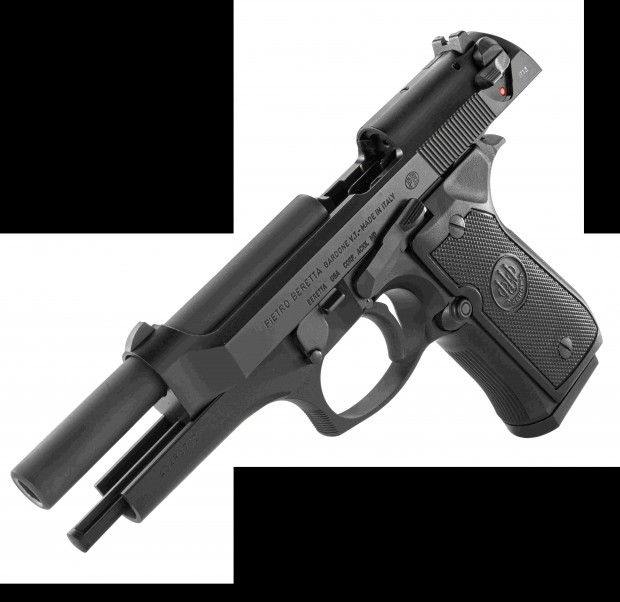
The classic Beretta 92FS/M9 with its slide locked to the rear.
–

Wilson Combat’s Battlesight with its “U” notch for a fast accurate sight picture.
–
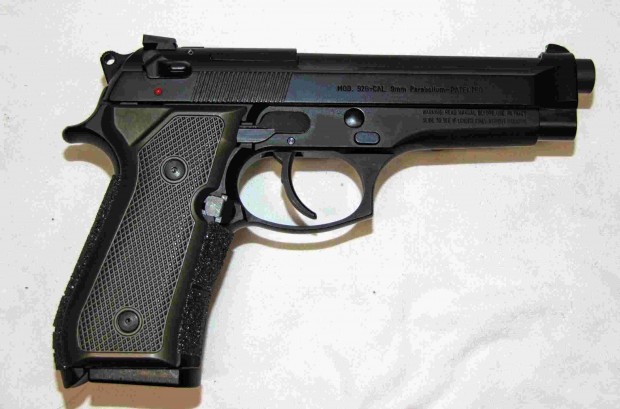
Pre refinishing 92G so you can see the OD green Aluma Grips.
–
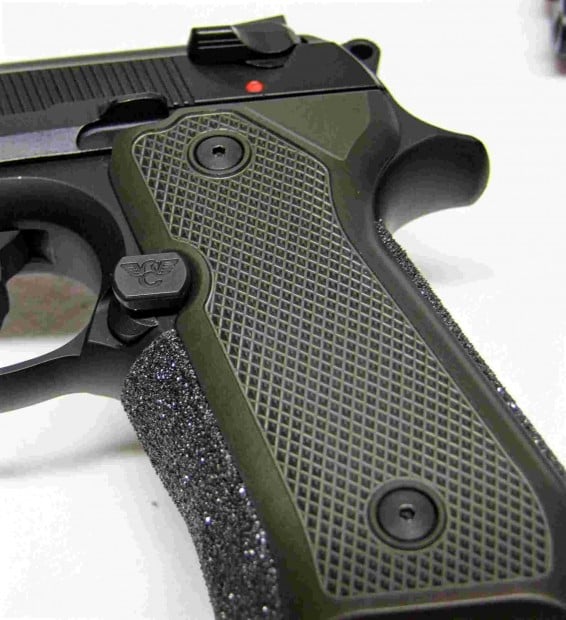
Close-up of the WC Extended Magazine Release and the anti-skid tape for added purchase in all conditions.
–
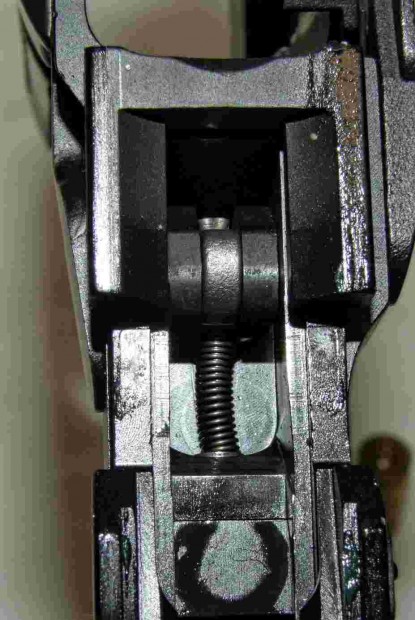
Close-up of the WC Trigger Conversion Unit, this unit gives a smoother lighter trigger pull.
–
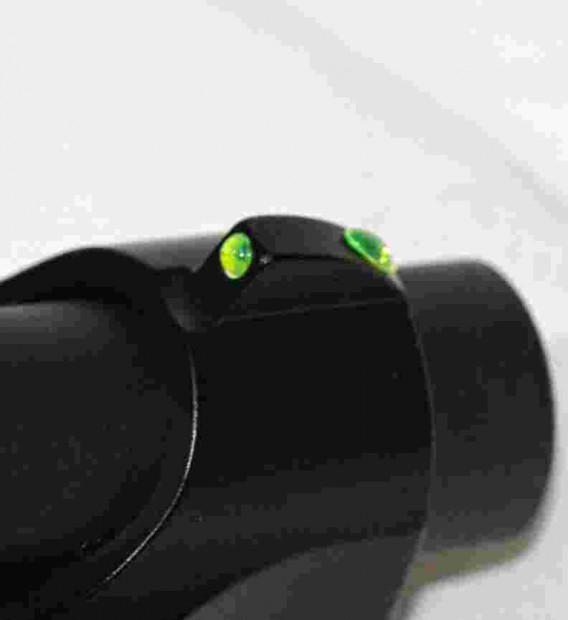
To reduce cost, WC drills out the factory front sight and installs a fiber optic pipette to give the shooter a bright front sight.
–
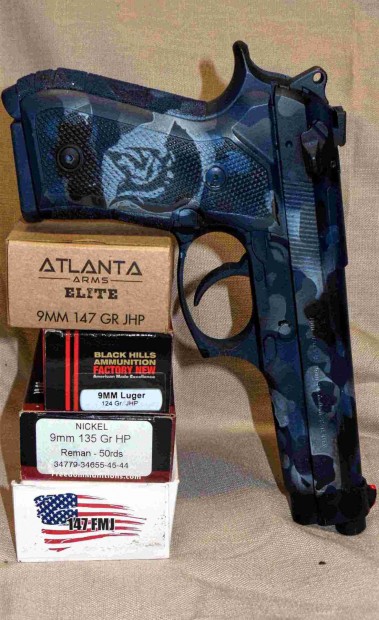
Author’s 92G with its test ammunition, you can see the Spartan from Montactical to make the pistol even more unique.
–

The 92G is resting in the simple Galco Yaqui Slide with Mernickle’s Wild Bunch on the left and Safariland’s GLS Pro Fit done in custom Kryptek by the author.
—
Scott Smith is a Disabled Veteran serving in the Army and USAF Reserve. He has been a federal police officer, is a charter member of IDPA and is actively involved with USPSA and various three gun competitions.


